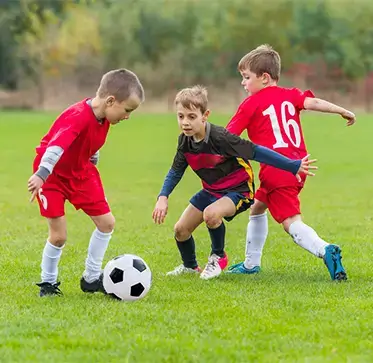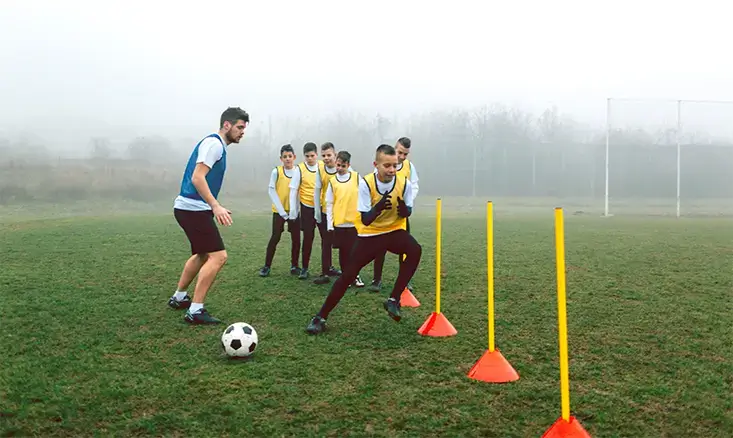12 Effective Aggression Drills for Youth Soccer Players

CRFC BLOGS
LATEST BLOGS & NEWSLETTERS
12 Effective Aggression Drills for Youth Soccer Players
Youth Soccer Aggression
Fundamental Aggression Drills for Youth Soccer Players
50/50 Ball Drills
50/50 ball drills are crucial for teaching players how to confidently compete for the ball when both teams have an equal chance of getting it. These drills help build confidence and the ability to compete under pressure. Encourage players to use their bodies legally to shield the ball and win possession.
Method
Set up a scenario where two players compete for possession of the ball. The coach can roll or toss the ball between them, and the players must race to win it.
Benefits
Encourages physicality and competitive spirit. Players learn to use their bodies effectively to gain possession.
First to the Ball Drills
First to the ball drills are great for enhancing reaction times and assertiveness. These drills teach players to be proactive and aggressive in winning the ball. Emphasize the importance of quick movements and decisive actions.
Method
Create a grid and place two players at opposite ends. The coach calls out “Go!” and the players race to the ball placed in the center.
Benefits
Builds aggressiveness and quick decision-making. Players develop a fast reaction time and determination to win the ball.

Aggressive Play Drills for Younger Players
King of the Hill
Method
Set up a small area and place several players inside with one ball. Players compete to keep possession while others try to take it away. The player who maintains possession the longest is the “King of the Hill.”
Benefits
Enhances competitive play and ball protection. Players develop determination and aggressive play in a fun setting.
Defensive Aggression Drills
1v1 Defensive Drills
1v1 defensive drills teach players to be aggressive and effective in one-on-one situations. These drills help defenders develop the confidence and skill needed to challenge attackers and win the ball. Focus on proper body positioning and timing for tackles.
Method
Set up a one-on-one scenario where a defender faces an attacker. The attacker tries to dribble past the defender, who must use aggressive but legal tactics to stop them.
Benefits
Improves tackling and pressure on the ball. Players learn to defend assertively without committing fouls.
Shoulder Tackle Drills
Method
Practice shoulder tackles by having players pair up and challenge each other for the ball using their shoulders. Ensure that players understand the legal limits of a shoulder tackle.
Benefits
Teaches safe and effective physical challenges. Players learn to use their body strength to win possession.
Two-Ball Scrimmage
Two-ball scrimmages create a high-intensity environment where players must stay alert and aggressive. This drill helps players improve their ability to handle multiple challenges at once and maintain a high level of intensity throughout the game.
Method
In a small-sided game, introduce a second ball. Players must compete for both balls simultaneously, increasing the intensity and competitiveness of the game.
Benefits
Increases the need for quick decision-making and aggressive play. Players develop multitasking skills and assertiveness.

High-Intensity Attack Drills
Aggression in attack is about putting pressure on the defense and creating scoring opportunities. These drills help players develop an aggressive attacking mindset.
High-Pressure Drills
High-pressure drills teach players to respond aggressively and quickly after losing possession. These drills help attackers develop a relentless attitude, crucial for high-intensity play. Emphasize the importance of teamwork and communication in applying effective pressure.
Method
Set up a drill where attackers apply immediate pressure on defenders after losing the ball. The goal is to regain possession quickly and create scoring chances.
Benefits
Builds an aggressive attacking mindset. Players learn to press high and maintain intensity in their play.
Quick Transition Drills
Quick transition drills are vital for developing an aggressive and effective attacking style. These drills help players learn to capitalize on opportunities quickly and maintain a high tempo in their play. Encourage players to think ahead and be proactive in their movements.
Method
Practice drills that focus on rapid transitions from defense to attack. For example, after winning the ball, players must quickly move forward to create a scoring opportunity.
Benefits
Encourages quick and aggressive forward play. Players develop the ability to switch from defense to attack smoothly.
Battle Zones
Battle Zones are great for using one-on-one competition and teaching players to assert themselves. This drill helps players build confidence and aggression in direct confrontations.
Method
Divide the field into several small “battle zones.” In each zone, two players compete for possession of the ball. Rotate players through different zones to experience various opponents.
Benefits
Encourages one-on-one competition and aggressive play. Players develop confidence and assertiveness in individual battles.
Small-Sided Games with Focus on Aggression
Small-sided games are excellent for practicing aggressive play in a realistic context. These games help players apply the skills they’ve learned in drills to actual game situations. Encourage players to be assertive and competitive while maintaining fair play.
Method
Organize small-sided games (e.g., 3v3 or 4v4) with an emphasis on aggressive play. Encourage players to compete for every ball and use their bodies to shield and win possession.
Benefits
Applies aggressive tactics in a game setting. Players learn to integrate aggressive play into their overall game strategy.

Techniques to Enhance Aggressiveness
Teaching players to use aggression effectively without compromising sportsmanship is crucial. These techniques focus on controlled aggression and mental toughness.
Controlled Aggression Techniques
Controlled aggression is about being assertive and determined while maintaining control and discipline. Teach players to use their bodies and physicality within the rules of the game. This approach helps players build confidence and a competitive edge without resorting to fouls.
Method
Educate players on the importance of using aggression positively. Practice drills that emphasize assertiveness, such as challenging for the ball and shielding it from opponents.
Benefits
Improves competitive edge and game control. Players learn to channel their aggression effectively.
Mental Toughness Drills
Mental toughness is a key component of aggressive play. Drills that challenge players’ mental resilience help them develop the ability to stay focused and determined, even in difficult situations. Encourage players to stay positive and keep pushing themselves.
Method
Implement drills that focus on building mental resilience and aggression. For example, practice scenarios where players must recover quickly from mistakes and continue to compete aggressively.
Benefits
Enhances focus and aggressive mindset. Players develop the mental toughness needed to stay competitive under pressure.
Encouraging Positive Aggression
It’s essential to teach players that aggression in soccer should always be positive and controlled. Encourage players to compete with determination and respect for their opponents.
Team Building and Sportsmanship
Team-building exercises help players understand the importance of respect and fair play. By discussing the role of aggression in soccer, coaches can guide players on how to use their competitive spirit positively.
Method
Incorporate team-building exercises that emphasize the importance of respect and sportsmanship. Discuss the role of aggression in soccer and how to use it positively.
Benefits
Reinforces the values of fair play and respect. Players learn to balance aggression with good sportsmanship.

Join our summer soccer camps to learn and master youth soccer aggression drills.
Conclusion
From fundamental aggression techniques to advanced defensive and attacking drills, these exercises help youth soccer players build a strong foundation for aggressive play. Consistency and regular practice are crucial for improvement, and it’s important for players to enjoy the learning process. By incorporating these drills into their training routine, youth players can develop their aggression and become more confident and effective on the field. To maximize their learning and practice opportunities, players can join summer soccer camps that offer a mix of fun, training, and skill development customized to their age group.
FAQs
How can young players improve their aggression in soccer?
To improve aggression in soccer, young players should practice specific drills like 50/50 ball drills and shoulder tackles. These exercises teach them to compete confidently for the ball and use their bodies effectively to challenge opponents.
What are the four types of aggression in soccer?
The four types of aggression in soccer include physical aggression (using body contact to win the ball), verbal aggression (communicating assertively on the field), mental aggression (maintaining a competitive mindset), and tactical aggression (making strategic decisions to disrupt the opponent’s play).
How do you practice soccer aggression drills effectively?
Practicing soccer aggression drills effectively involves consistent training with focused drills such as 1v1 challenges, 50/50 ball scenarios, and small-sided games. These drills help players develop assertiveness, improve their tackling skills, and enhance their ability to win possession.
How can coaches teach aggressive tackling to youth players?
Coaches can teach aggressive tackling by demonstrating proper techniques, emphasizing safety, and using drills like shoulder tackles and 1v1 defensive challenges. These drills help players learn how to use their bodies to win the ball without committing fouls.
What tips help players become aggressive defenders in soccer?
To become an aggressive defender, players should focus on staying close to their opponents, anticipating their moves, and using their bodies to block and challenge effectively. Practicing defensive drills that emphasize quick reactions and physicality will help develop these skills.

Did you find this useful?


